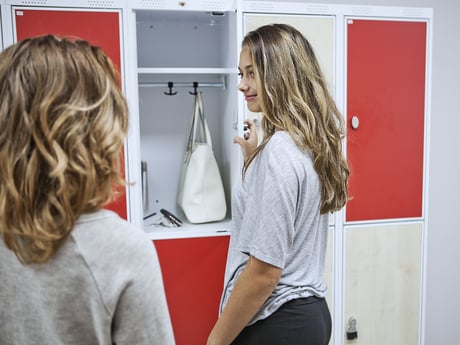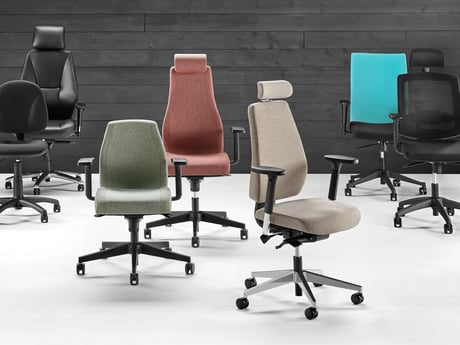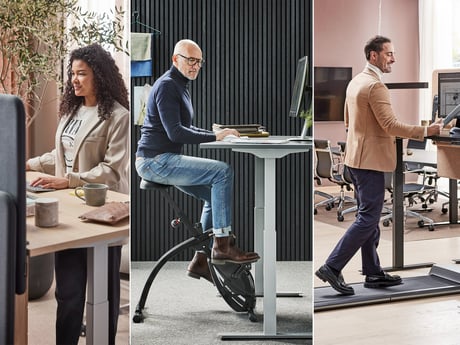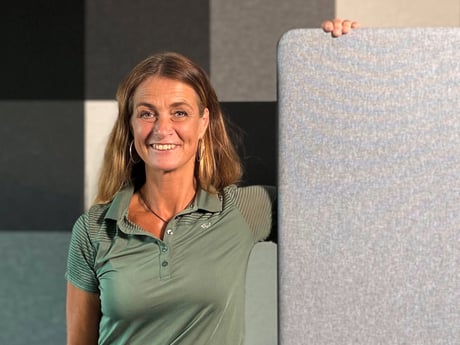- AJ Products UK
- Blog: Tips to Inspire Happiness at Work
- Ergonomics in the workplace
- Get in the saddle: 10 benefits of saddle chairs
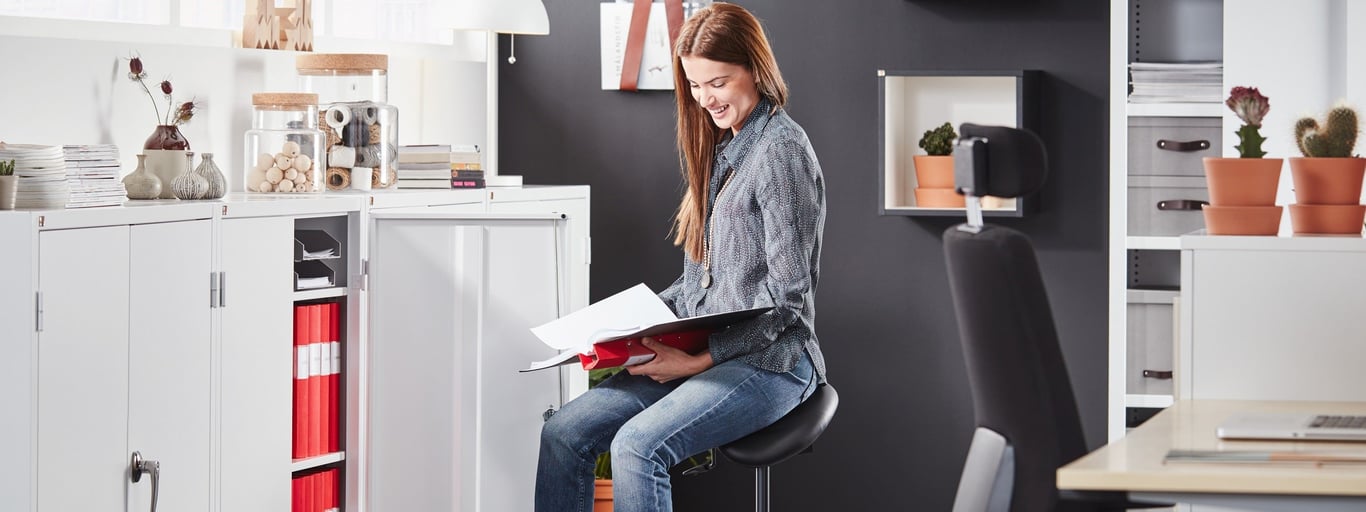
The Ultimate Guide to Saddle Chairs
Introduction
Sitting for extended periods has become a reality for many professionals in today’s workplace. However, sitting on conventional office chairs often exacerbate problems like poor posture, back pain and reduced productivity. Enter saddle chairs: an innovative solution designed to transform the way we sit by promoting active movement and ergonomic support.
Initially popular in industries like healthcare and creative fields, saddle chairs are now gaining traction in modern office environments as part of a broader push towards healthier work habits. In this guide, we’ll explore what makes saddle chairs unique, their wide-ranging benefits and how they compare to traditional seating options. Whether you’re looking to improve your posture, reduce back pain, or create a more dynamic work environment, this guide has everything you need to know.
What is a Saddle Chair?
A saddle chair is a specialised ergonomic seating solution designed to mimic the shape of a horse’s saddle. Unlike traditional office chairs, a saddle chair positions the thighs at a downward angle, creating an open hip joint angle of approximately 135°. This unique posture encourages a natural alignment of the spine, reduces strain on the lower back, and actively engages the core muscles.
By shifting the sitting angle, saddle seating help distribute body weight more evenly, reducing pressure on the lumbar discs and improving overall comfort. This makes them an ideal choice for professionals who spend long hours at their desks or require enhanced mobility, such as healthcare practitioners, designers and office workers.
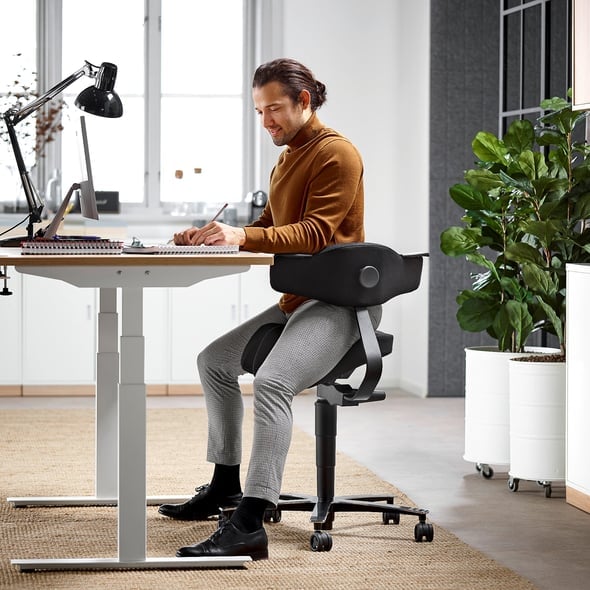
Why Businesses Are Embracing Saddle Chairs
As organisations prioritise employee wellness and ergonomic solutions, saddle chairs are emerging as a game-changer in modern workplaces. Prolonged sitting is often linked to musculoskeletal disorders, with research indicating that over 80% of office workers experience back pain at some point in their careers. Saddle chairs address this issue by encouraging active sitting and reducing physical strain.
Key Reasons for the Shift
- Improved Employee Health: Saddle chairs promote better posture, reducing the risk of chronic pain and long-term health issues.
- Enhanced Productivity: Comfortable and dynamic seating helps employees stay focused and engaged throughout the day.
- Alignment with Wellness Trends: Companies are increasingly investing in ergonomic furniture to support workplace wellness initiatives.
From healthcare to creative industries, businesses are recognising the value of saddle chairs as a long-term investment in both employee satisfaction and productivity.
Comprehensive Benefits of Saddle Chairs and Saddle Stools
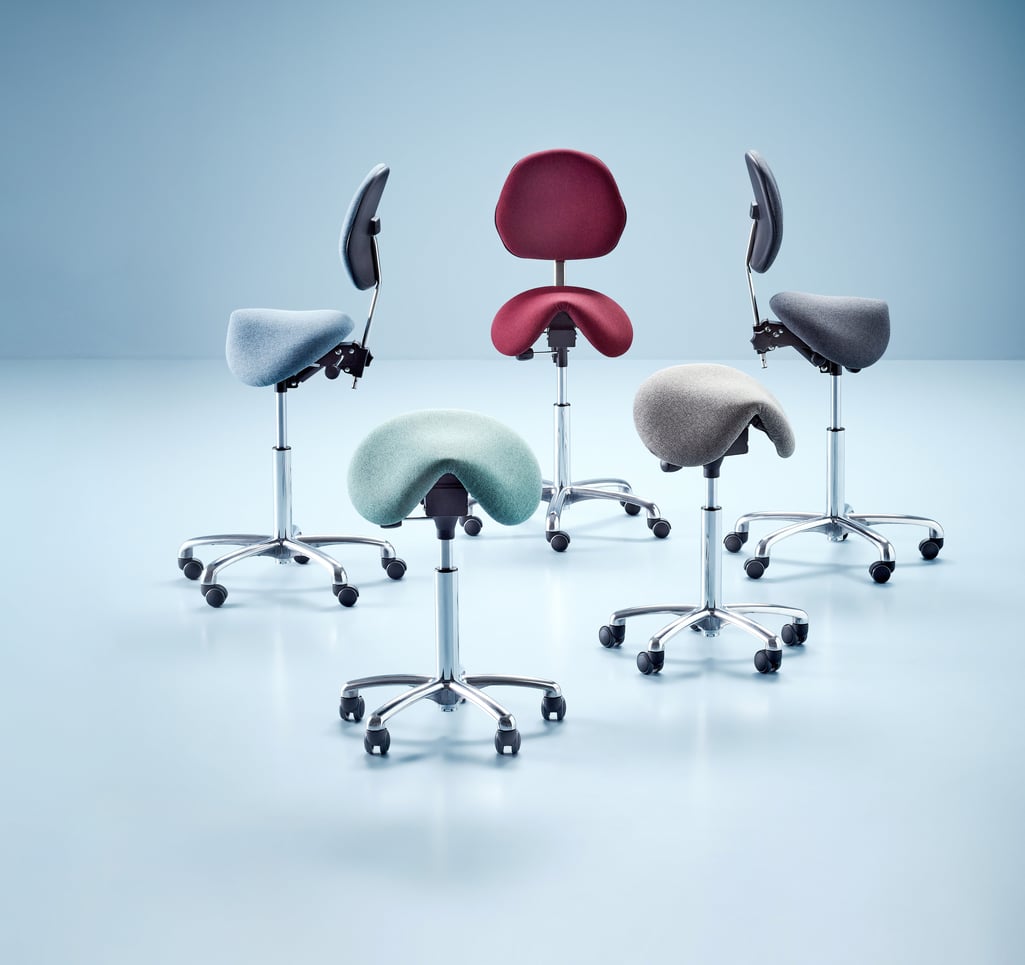
Saddle chairs and stools are more than just an ergonomic alternative to traditional seating; they offer a range of benefits designed to enhance physical well-being and workplace productivity. Below, we explore the key advantages in detail:
1. Posture Correction
2. Enhanced Circulation
3. Core Strength and Engagement Sitting on a saddle chair engages the core muscles, as the design requires balance and stability. Over time, this active engagement strengthens the abdominal and lower back muscles, leading to improved posture and reduced risk of injury.
4. Improved Focus and Productivity
CLICK TO VIEW BENEFITS COMPARISON TABLE
| Benefit | How It Helps |
|---|---|
| Posture Correction | Aligns the spine and reduces back pain |
| Enhanced Circulation | Improves blood flow and prevents leg discomfort |
| Core Engagement | Activates abdominal and back muscles |
| Increased Productivity | Reduces discomfort, improving focus |
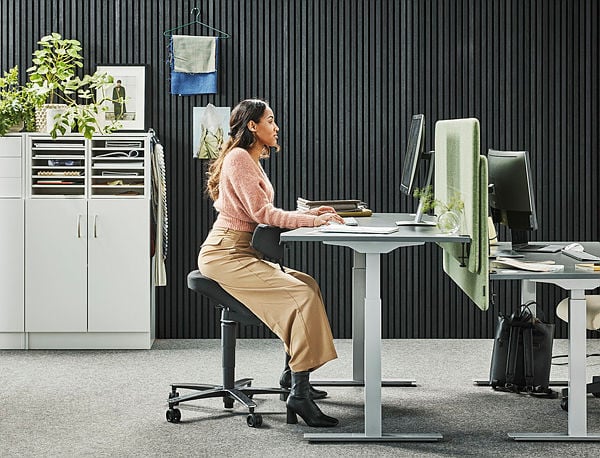
Comparing Saddle Chairs and Traditional Chairs
When choosing an ergonomic seating option, it’s important to understand how saddle chairs compare to traditional office chairs. Below, we break down the key differences:
| Feature | Saddle Chair | Traditional Chair |
|---|---|---|
| Posture Support | Promotes natural spinal alignment | Often leads to slouching |
| Core Engagement | Activates core muscles | Minimal core activation |
| Circulation | Improves leg blood flow | May restrict blood flow |
| Comfort Over Time | Encourages active sitting and movement | Can cause discomfort during long hours |
| Mobility | Allows for a greater range of motion | Limited by chair design |
Saddle chairs outperform traditional chairs in multiple aspects, making them an ideal choice for individuals prioritising health and productivity.
How to Choose the Right Saddle Chair
Selecting the right saddle seat depends on your specific needs and workspace setup. Here are some key factors to consider:
Split Seat vs Solid Seat: Split seats provide better ventilation and reduce pressure on the pelvic area, making them ideal for prolonged sitting. Solid seats offer a more traditional design and are often preferred for lighter use.
Look for chairs with adjustable height and tilt settings to ensure compatibility with your desk and body type. Proper adjustments help maintain optimal posture and prevent discomfort.
Choose a chair with durable materials and appropriate cushioning. While firmer seats encourage active sitting, softer cushions may suit those transitioning from traditional chairs.
Consider your work environment. For example, healthcare professionals may prioritise mobility, while office workers may focus on posture support and desk compatibility.
How to Transition to a Saddle Chair
Switching to a saddle chair can be transformative, but it requires a period of adjustment to ensure comfort and effectiveness. Follow these steps for a smooth transition:
Begin by using the saddle chair for short intervals, such as 1–2 hours per day. Gradually increase your usage as your body adjusts to the new posture.
Ensure the chair is set at the correct height and tilt to maintain a 135° hip angle. Pair it with a desk at the appropriate height to prevent strain on your wrists and shoulders.
Take regular breaks to stand, stretch, and move around. This complements the active sitting benefits of the saddle chair and prevents stiffness.
It’s natural to feel some discomfort during the adjustment period, but this should not persist. If pain or significant discomfort occurs, reassess your chair’s settings or consult an ergonomic specialist.
Common Misconceptions About Saddle Chairs
Despite their proven benefits, saddle chairs are often misunderstood. Let’s address some of the most common myths:
This misconception usually stems from improper usage. When adjusted correctly, saddle chairs are designed to enhance comfort by promoting natural posture and reducing strain.
While initially popular in medical and creative industries, saddle chairs are versatile enough for corporate offices, home workspaces, and other environments where sitting for long periods is common.
Although saddle chairs may have a higher upfront cost, they are a long-term investment in health. Reduced healthcare costs and improved productivity often outweigh the initial expense.
Saddle Chairs in the Workplace of the Future
The shift towards wellness-focused workplaces has positioned saddle chairs as a key element of modern office design. As more businesses adopt ergonomic solutions, saddle chairs are playing an integral role in creating healthier, more productive environments.
Pairing saddle chairs with height-adjustable desks and standing workstations encourages dynamic movement, a hallmark of active workplaces.
In hybrid work environments, saddle chairs offer the flexibility to support both home and office setups, ensuring consistent ergonomic benefits across locations.
Future developments may include smart saddle chairs with posture monitoring and adjustment reminders, further enhancing their appeal in tech-forward workplaces.
Conclusion: Why Saddle Chairs Are Worth It
Saddle chairs represent a significant step forward in ergonomic seating solutions. By promoting better posture, enhancing productivity, and supporting long-term health, they address many of the challenges posed by traditional office seating.
Whether you’re a healthcare professional, an office worker or a creative, saddle chairs offer a versatile and impactful way to improve your work environment. With their ability to reduce back pain and encourage active sitting, they are not just a purchase, they’re an investment in your well-being.
Take the next step: Explore our range of high-quality saddle chairs and transform your workspace into a hub of health and productivity.
